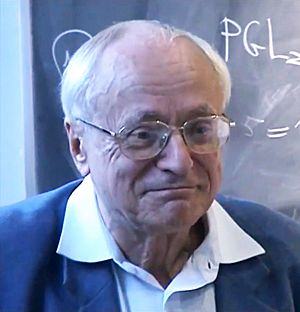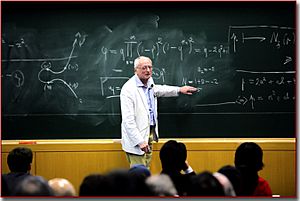Jean-Pierre Serre facts for kids
Quick facts for kids
Jean-Pierre Serre
|
|
|---|---|

Serre in 2003
|
|
| Born | 15 September 1926 Bages, Pyrénées-Orientales, France
|
| Alma mater | |
| Known for | (List of things named after Jean-Pierre Serre) |
| Awards |
|
| Scientific career | |
| Fields | Mathematics |
| Institutions |
|
| Thesis | Homologie singulière des espaces fibrés (1951) |
| Doctoral advisor | Henri Cartan |
| Doctoral students |
|
Jean-Pierre Serre (born September 15, 1926) is a famous French mathematician. He has done important work in different areas of mathematics, like algebraic topology, algebraic geometry, and algebraic number theory. He received many top awards for his work, including the Fields Medal in 1954, the Wolf Prize in 2000, and the very first Abel Prize in 2003.
Contents
About Jean-Pierre Serre
Early Life and Education
Jean-Pierre Serre was born in Bages, France. His parents were pharmacists. He went to school at the Lycée de Nîmes.
After high school, he studied at the École Normale Supérieure in Paris from 1945 to 1948. He earned his doctorate degree from the Sorbonne in 1951.
Career as a Mathematician
From 1948 to 1954, Serre worked at the Centre National de la Recherche Scientifique in Paris. In 1956, he became a professor at the Collège de France. He taught there until he retired in 1994.
Serre was a very talented mathematician from a young age. He worked with Henri Cartan, another famous mathematician. Serre focused on areas like algebraic topology and algebraic geometry. He helped develop new ways of thinking about these subjects.
His early work included studying something called the Leray–Serre spectral sequence. He also worked with Cartan to use Eilenberg–MacLane spaces. These were important tools for solving big problems in topology at the time.
In 1954, Serre was awarded the Fields Medal. This is one of the highest honors a mathematician can receive. He was only 27 years old, making him the youngest person ever to win it.
Working with Alexander Grothendieck
In the 1950s and 1960s, Serre worked closely with another brilliant mathematician, Alexander Grothendieck. They did important work together, especially in algebraic geometry. Their work helped to solve some very complex math problems.
Serre wrote two important papers: Faisceaux Algébriques Cohérents (FAC, 1955) and Géométrie Algébrique et Géométrie Analytique (GAGA, 1956). These papers introduced new ideas that changed how mathematicians studied algebraic geometry.
Serre also helped inspire the development of something called étale cohomology. This was a new way to study shapes and spaces in mathematics. These tools were later used by Pierre Deligne to prove the Weil conjectures, which were very famous unsolved problems.
Other Important Contributions
From 1959 onwards, Serre became interested in other areas of mathematics. These included group theory and number theory. He worked on topics like Galois representations and modular forms.
Some of his unique ideas include his "Conjecture II" about Galois cohomology. He also used group actions on trees with Hyman Bass. Serre also contributed to the study of p-adic modular forms.
One of his most famous contributions is the Serre conjecture. This idea helped connect Fermat's Last Theorem to a major part of arithmetic geometry. The Serre conjecture is now a proven theorem.
In his paper FAC, Serre asked a question about projective modules. This question led to a lot of new research in commutative algebra. The question was finally answered in 1976 by Daniel Quillen and Andrei Suslin. Their solution is now known as the Quillen–Suslin theorem.
Awards and Honors
Jean-Pierre Serre has received many of the highest awards in mathematics. As mentioned, he won the Fields Medal in 1954 when he was just 27.
He also won the Balzan Prize in 1985 and the Steele Prize in 1995. In 2000, he received the Wolf Prize in Mathematics. In 2003, he was the very first person to be awarded the Abel Prize. He also received the Gold Medal from the French National Scientific Research Centre (CNRS).
Serre is a member of many important scientific groups around the world. These include Academies in the US, Norway, Sweden, and Russia. He is also a foreign member of the Royal Society and the Royal Netherlands Academy of Arts and Sciences. Many universities, like Cambridge, Oxford, and Harvard, have given him honorary degrees. In 2012, he became a fellow of the American Mathematical Society.
In France, Serre has received the highest honors. He is a Grand Cross of the Legion of Honour and a Grand Cross of the Legion of Merit.
See also
 In Spanish: Jean-Pierre Serre para niños
In Spanish: Jean-Pierre Serre para niños
- Multiplicity (mathematics)
- Bourbaki group — Serre joined it in the late 1940s
Images for kids



